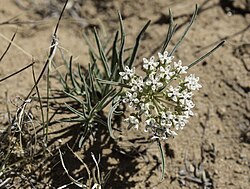Biology:Asclepias involucrata
| Asclepias involucrata | |
|---|---|

| |
| Asclepias involucrata blooming in Sandoval County, New Mexico | |
| Scientific classification | |
| Kingdom: | Plantae |
| Clade: | Tracheophytes |
| Clade: | Angiosperms |
| Clade: | Eudicots |
| Clade: | Asterids |
| Order: | Gentianales |
| Family: | Apocynaceae |
| Genus: | Asclepias |
| Species: | A. involucrata
|
| Binomial name | |
| Asclepias involucrata Engelm. ex Torr.[1]
| |
| Synonyms[1] | |
| |
Asclepias involucrata, synonym Asclepias macrosperma, (dwarf milkweed) is a perennial plant in the family Apocynaceae native from the west and south central United States to north Mexico.[1] In the southwestern United States, it is found in the Colorado Plateau and Canyonlands region.[2]:138
Description
It is a perennial plant 2 to 10 inches (5.1 to 25.4 cm) long with stems lying on the ground. The leaves and stems are densely covered with hair. It blooms from April to June. The flowers are in clusters at the ends of stems, with five greenish-white downward bent petals and five greenish-white pouch-like sacs. The seedpods are shaped like spindles.[2]:138
Distribution and habitat
Asclepias involucrata is native to Arizona, Colorado, Kansas , New Mexico, Oklahoma, Texas , and Utah in the United States and to Northeast and Northwest Mexico.[1] It can be found in mixed desert shrub and pinyon juniper woodland communities.[2]:138
Uses
The Zuni people mix the dry powdered root with saliva and use it for an unspecified illness.[3] The Zuni also note that this plant is favored by jackrabbits.[4]
References
- ↑ 1.0 1.1 1.2 1.3 "Asclepias involucrata Engelm. ex Torr.." (in en). Royal Botanic Gardens, Kew. http://www.plantsoftheworldonline.org/taxon/94357-1.
- ↑ 2.0 2.1 2.2 Canyon Country Wildflowers, Damian Fagan, 2nd ed., 2012, Morris Bush Publishing, LLC. in cooperation with Canyonlands Natural History Association, ISBN:978-0-7627-7013-7
- ↑ Camazine, Scott and Robert A. Bye 1980 A Study Of The Medical Ethnobotany Of The Zuni Indians of New Mexico. Journal of Ethnopharmacology 2:365-388 (p. 373)
- ↑ Stevenson, Matilda Coxe 1915 Ethnobotany of the Zuni Indians. SI-BAE Annual Report #30 (p. 65)
Wikidata ☰ {{{from}}} entry
 |

